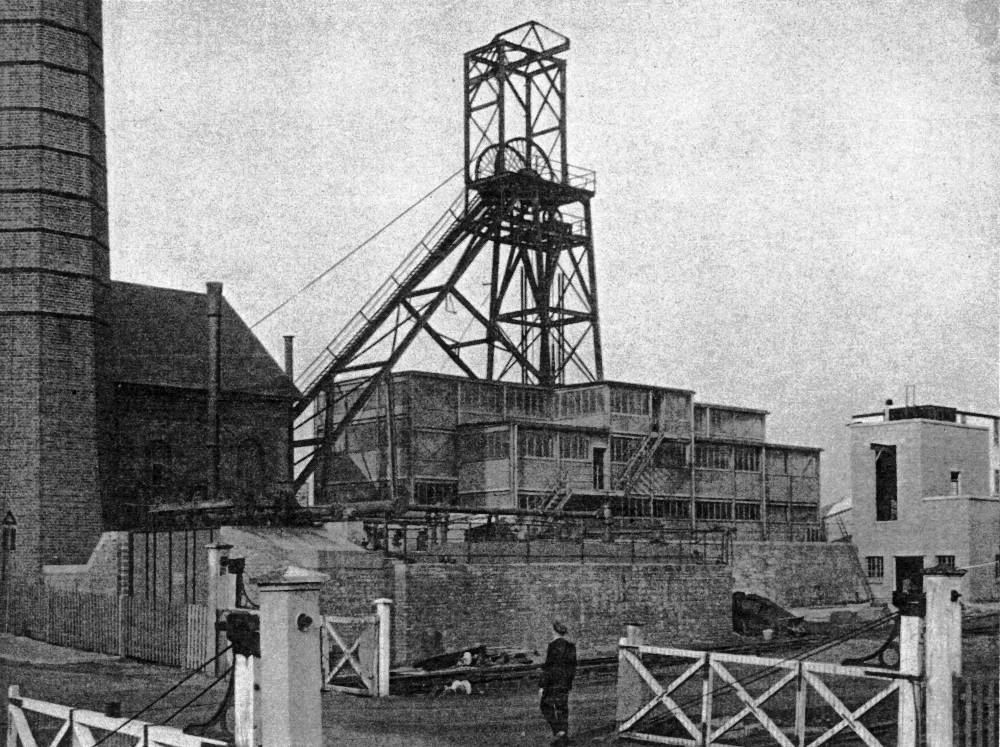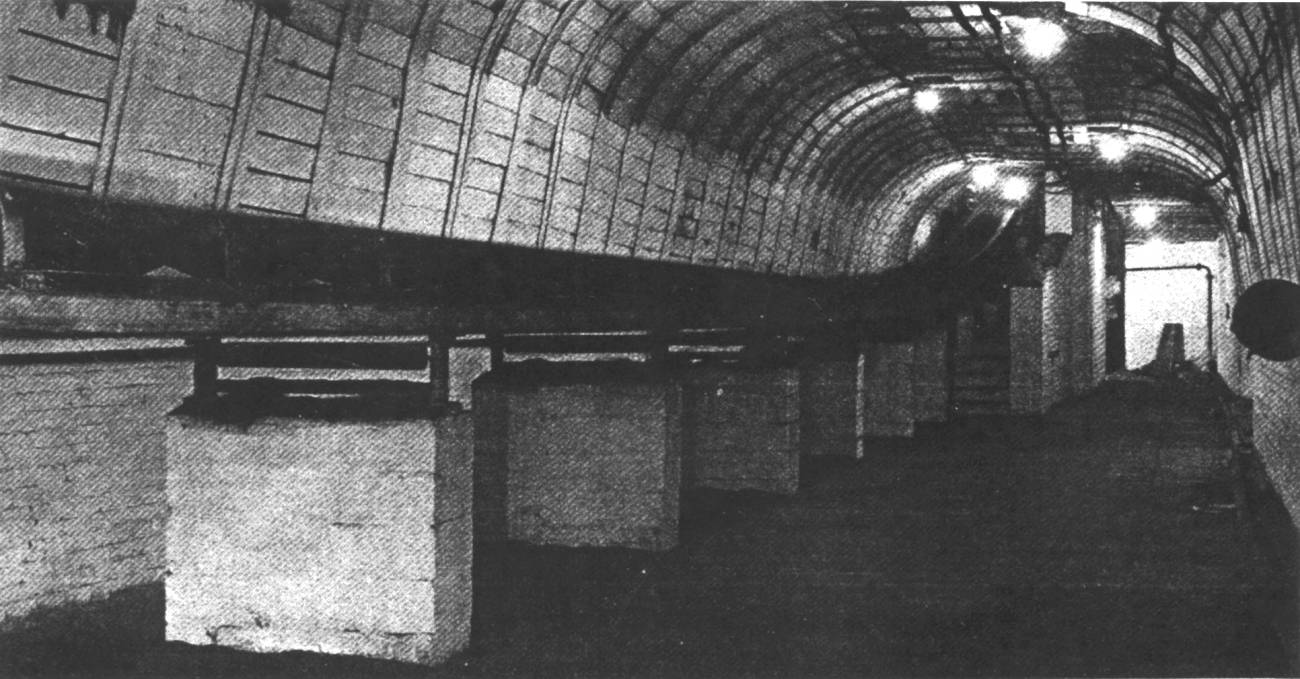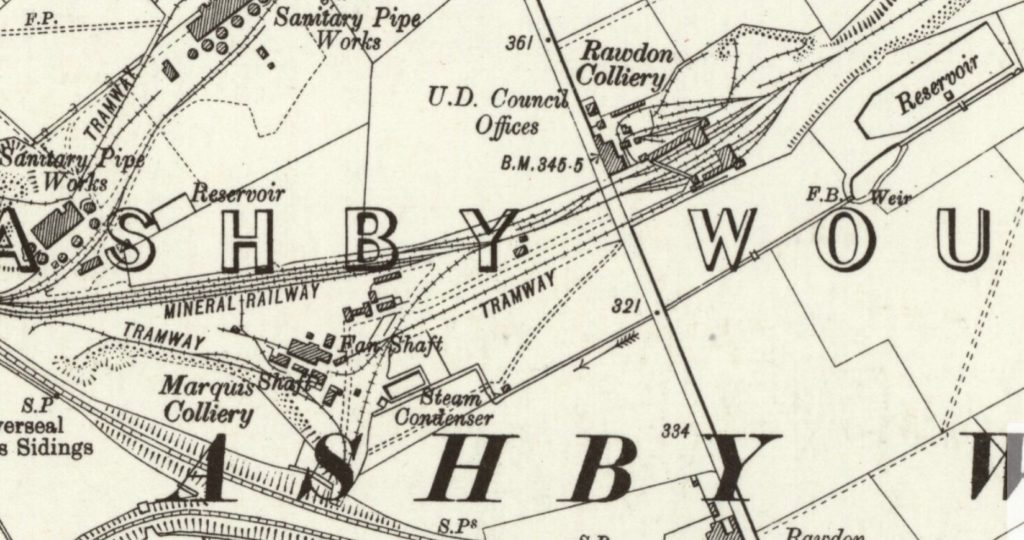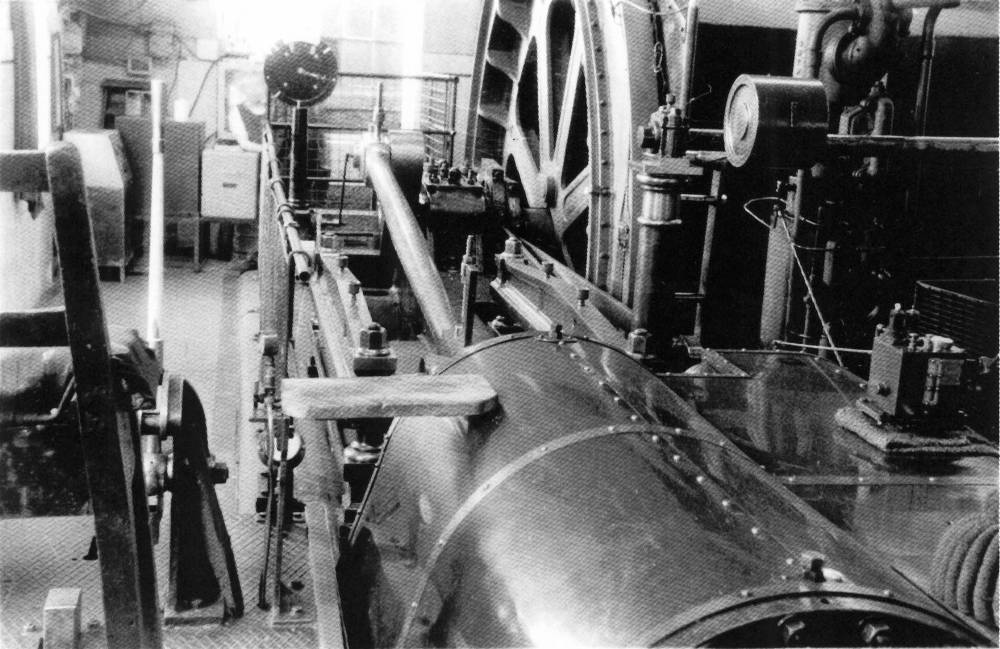RAWDON COLLIERY (SK 312162)

Headgear and new heapstead building, 1953 – Colliery Engineering
Rawdon Colliery was sunk in 1821 and reached the Main Coal seam at 247 yards from the surface. Rawdon was now one of five collieries at Moira owned by the Earl of Moira. For many years it proved to be a troublesome colliery and operations ceased in 1844. With apparently some optimism the Rawdon shaft was deepened in 1868 to reach the Stanhope seam at 362 yards, and the colliery re-opened in 1874. Further difficulties ensued and coal winning ceased again in 1877. Flooding occurred in 1880 following a severe storm.
By 1885, the closure of the owner’s colliery at Oakthorpe was looming nearer and efforts were made to bring Rawdon back into production. Mining was taking place by 1889 on a small scale but there were still problems with faulting of the strata, gob fires and drainage. Labour relations were also worsening and there was a long strike in 1893. Following the death of the then owner, a Limited Company was formed, the Moira Colliery Company Limited, on 1 October 1895. From then on a programme of reconstruction and improvements was instigated at the Company’s collieries, which included Rawdon and a much more planned existence was entered into.
Shaft – There was a single shaft at Rawdon, 12 feet diameter, and after the 1868-1874 deepening had reached the Stanhope seam at 362 yards from the surface. This shaft remained in use for coal winding until 1977 when it was replaced for this purpose by a drift sunk from the surface at Marquis Colliery.
Winding – A new winding engine was obtained in 1868 to serve the deepened shaft. From the rather chequered history of the colliery it does not appear to have done a great deal of work for some years.
The new engine was a twin cylinder horizontal with 30in. x 60in. cylinders, built by Messrs. Handyside of Derby. The pistons were fitted with tail rods. The winding drum was parallel and carried round wire winding ropes from new.
Major renewal work was carried out on the engine in 1917. A new 14ft. 6in. diameter winding drum and a new crankshaft were fitted together with a steam reverser and new brakes. Overwinding control gear and new electrical shaft signalling was also installed. Further work was carried out in 1936 when new adjustable crankshaft bearings were provided.
Extensive rebuilding was done in 1953 when Worsley Mesnes Ironworks of Wigan fitted new 26in. x 60in. piston valve cylinders and governor controlled expansion gear, together with new pistons, piston rods, crank pins and brasses. This was followed in 1964 by the provision of new main bearings, bearing pedestals and crankshaft, plus new coupling rods for the brakes. Finally in 1967, a new fabricated steel bedplate was fitted to the left hand engine. By this time, the right hand bedplate and two connecting rods remained of the 1868 engine.
In its final form, the piston valves were plain, without any means of varying the cut-off. The cut-off control governor was still present but was not connected to anything. Operation of the piston valves was by Stephenson’s link motion. The eccentrics were mounted on outboard shafts driven by drag cranks from the engine crankpins. Reversing and braking were by a Melling’s (Worsley Mesnes) reversing engine and Melling’s brake engine respectively. The latter operated straight post brakes which acted upon brake paths on each side of the winding drum. Overwind and overspeed protection was by a Melling’s pneumatic controller.
Winding was from 366 yards and the winding ropes were one and five sixteenths inches diameter, locked-coil type. Exhaust steam from the winding engine passed into old Lancashire and Cornish boilers converted to serve as boiler feed water heaters. They probably acted as silencers as well.
The general construction of the engine was typical 19th century with flat bedplates and four-bar crosshead guides. Over the years the bedplates had obviously been well stressed. At some time, not now known the piston tail rods were ordered to be “sawn off” by the then Area Chief Engineer of the National Coal Board.
During the period 1895 – 1914 improvements to the winding arrangements included the erection of a new steel headgear. New multi-deck cages were also provided together with wire rope cage conductors. The tubs were of 16½ cwt. capacity.
In 1953, a container winding system was introduced which was unique to Rawdon. This was the joint invention of Mr. J.J. Torrance OBE., Area General Manager and Mr. F. Ashley, Area Chief Engineer, and was known as the “Torley” system.

Trunk conveyor carrying coal from the main West District to pit bottom bunker
Colliery Engineering 1953
Six containers were used which allowed for loading, tipping and transit in the cages, so that a virtually continuous flow of coal was maintained. Coal was fed into the containers at the pit bottom by a feeder from a bunker which in turn was fed by trunk belt conveyors from the working districts. The system was fully automated and required one man at the pit bottom and another at the pit top to carry out all the loading and unloading functions. The controls were grouped into a console at the pit bottom and pit top respectively.
Motive power was provided by hydraulic rams, these in turn being supplied by electrically driven hydraulic pumps. All controls were electrically interlocked so that one function had to be completed and proved before the next one was commenced. Maximum hydraulic pressure was 800 psi.
The basic cycle of operation was (i) fill container at pit bottom. (ii) ram container into cage at pit bottom. (iii) wind container to surface. (iv) ram container out of cage and on to the tipping platform. (v) tip container to empty. A similar procedure then followed in reverse order for the empty container to be returned to the pit bottom.
The containers were constructed of light alloy with a steel bottom. Payload was 4 tons and the containers were moved along roller tracks.
The system was very successful initially and enabled all coal to be wound at the Rawdon shaft, eliminating the need to wind coal at the Marquis shaft. The ratio of tare weight to loaded weight of the containers was excellent. Eventually, however, problems developed in keeping the hydraulic equipment fluid tight and the Torley system was replaced by skip winding.
Skip winding overloaded the winding engine and it was reputed that the exhaust could be heard in Ashby-de-la-Zouch, 3 miles away. To reduce the starting load, a balance rope was fitted under the skips and other steps were taken to quieten the exhaust.
Coal winding ceased at Rawdon in late 1977 being replaced by a drift driven from the surface at Marquis pit. The steam winding engine was scrapped in 1980.
Boilers – The original boilers were egg-ended type which it was intended to replace at the time of the first engine reconstruction in 1917 with new boilers working at higher pressure. The Ministry of Munitions would not give permission for new boilers and replacement had to wait until 1919.
Four Lancashire boilers were installed, with the two outer boilers in the range being John Thompson dished-end type. The two inner boilers in the range were conventional flat-ended type with gusset stays. The maker of these two boilers is not now known. Working pressure of the whole range of boilers was 120 psi. A set of Green’s vertical tube economisers was installed in the main flue to the chimney.
The chimney serving the boilers was octagonal in cross-section, quite elegant and of considerable height. It was heavily re-enforced by closely spaced circumferential steel bands. During the National Coal Board era, the boilers were fitted with Danks’s chain grate mechanical stokers.
In the latter days, a Hodgkinson-Bennis ASH-VAC was installed. This consisted of a steam turbine driven fan which created a vacuum in a pipe under the firing floor and close to the boiler fronts. Grilled openings were provided in front of the furnace positions into which ash was drawn. Steam consumption of the apparatus was enormous and its use was soon abandoned.
Over the years, the brickwork settings of the boilers had deteriorated. A new Colliery Mechanical Engineer set about putting matters to rights, with the result that instead of four boilers working flat-out, three boilers easily sufficed.
During the 1970’s, the plain sections of the boiler furnace tubes had become distorted and these were renewed as required by the Boiler Inspector. Before renewal, it proved very difficult to obtain the true diameter of the distorted tubes. The draughtsman appointed to the job was a keen model engineer and he made up his own telescopic gauge which enabled the true diameter to be calculated. Northern Arc Welding, a well-known Leicester firm, did the job of welding the replacement sections of the furnace tubes into position. The work was done by the proprietor, Mr Jones, equally as well-known as his firm.
Power – Electrical power was generally adopted by the Moira Coal Co. in the early twentieth century i.e. prior to World War One. This included surface and underground lighting, coal cutters and haulage.
See also – Marquis Colliery.
Copyright © NMRS Records: Geoff Hayes Collection

OS Map, Derbyshire LX.SE 1921
Reproduced by permission of the National Library of Scotland


